
Porto, Portugal

Part I- Basic Principles in Salt Tectonics
Contents: 1.1- Effective Stresses 1.2- Tectonic Regimes in Sedimentary Basins 1.3- Stress Evolution in Tectonics 1.4- Salt Tectonics in Sedimentary Basins 1.4.1- Fold-Thrusts,t > 0 1.4.2- Compressive Strike-Slip,
t > 0 1.4.3- Lessening,
t > 0 1.4.4- Equilibrium (Halokinesis),
t = 0 1.4.5- Rifts - Extensional strike-slip,
t < 0 a) Salt Ridges b) Growth-Faults 1.5- Summary of Salt Extensional Tectonic Deformations
1.1- Effective Stresses
What deform the sediments? This simple question is often used to emphasize that the understanding of sedimentary deformation requires the knowledge of basic principles in tectonics. In facto, the more common and erroneous answer to this is question is - the tectonic stress (![]() t). The tectonic stress (
t). The tectonic stress (![]() t), which can be compressive or extensive, is an un-stabilising geological factor induced by an interaction of the lithospheric plates. It usually, acts more or less horizontally and is complementary to the lithostatic and hydrostatic pressures. When a tectonic stress (
t), which can be compressive or extensive, is an un-stabilising geological factor induced by an interaction of the lithospheric plates. It usually, acts more or less horizontally and is complementary to the lithostatic and hydrostatic pressures. When a tectonic stress (![]() t) is added in one direction it produces, by reaction, a lateral confining pressure (
t) is added in one direction it produces, by reaction, a lateral confining pressure (![]() g). In fact, the stresses responsible for any deformation are the effective stresses (
g). In fact, the stresses responsible for any deformation are the effective stresses (![]() 1,
1, ![]() 2,
2, ![]() 3), which correspond to the principal axes of the effective stresses ellipsoid (fig. 6). In a solid, stress is the force per unit area, acting on any surface within it, and variously expressed as pound or tons per square inch, or dynes or kilograms per square centimeter; also, by extension, the external pressure which creates the interval force. The stress at any point is mathematically defined by nine values: three to specify the normal components and six to specify the shear components, relative to three mutually perpendicular reference axes. Stress is a tensor of second rank. The forces area thought to act on every one of the infinitesimal elements of area with different orientation, which can be imagined at one point. Only such forces are considered which are locally in equilibrium with equal and opposite forces: tensor is symmetrical.
3), which correspond to the principal axes of the effective stresses ellipsoid (fig. 6). In a solid, stress is the force per unit area, acting on any surface within it, and variously expressed as pound or tons per square inch, or dynes or kilograms per square centimeter; also, by extension, the external pressure which creates the interval force. The stress at any point is mathematically defined by nine values: three to specify the normal components and six to specify the shear components, relative to three mutually perpendicular reference axes. Stress is a tensor of second rank. The forces area thought to act on every one of the infinitesimal elements of area with different orientation, which can be imagined at one point. Only such forces are considered which are locally in equilibrium with equal and opposite forces: tensor is symmetrical.
Fig. 6- The effective stresses, or the stresses responsible for the deformation of the rocks are the main axes of the effective stresses ellipsoid, which is the result of the addition of the geostatic or lithostatic stress (
g), the pore or hydrostatic pressure (
p) and the tectonic stress (the effective stresses ellipsoid, which is the result of the addition of the geostatic or lithostatic stress (
g), the pore or hydrostatic pressure (
t).
At a given depth, the geostatic or lithostatic stress (![]() g) is the stress (or pressure) caused by the weight of a column of the overlying beds. It can be represented by a biaxial ellipsoid:
g) is the stress (or pressure) caused by the weight of a column of the overlying beds. It can be represented by a biaxial ellipsoid: ![]() vertical =
vertical = ![]() v = d . g . h, and
v = d . g . h, and ![]() horizontal =
horizontal = ![]() h = confining pressure of
h = confining pressure of ![]() g. The geostatic stress ellipsoid varies with depth. The state of stress tends to become hydrostatic at great depth. At a given depth, the pore pressure or hydrostatic stress (
g. The geostatic stress ellipsoid varies with depth. The state of stress tends to become hydrostatic at great depth. At a given depth, the pore pressure or hydrostatic stress (![]() p) is the pressure of the interstitial fluids. It can be pictured by a uniaxial ellipsoid with:
p) is the pressure of the interstitial fluids. It can be pictured by a uniaxial ellipsoid with: ![]() pore =
pore = ![]() p = d’. g . h.
p = d’. g . h.
In geology, the fluid, generally water, saturating the open pore spaces of a rock column, has the same effect as immersing a rock in a water column. The tectonic stress (![]() t), which can be compressive or extensive, is a destabilizing geological factor induced by the interaction of the lithospheric plates. It acts more or less horizontally and is complementary to lithostatic and hydrostatic pressure. When tectonic stress (
t), which can be compressive or extensive, is a destabilizing geological factor induced by the interaction of the lithospheric plates. It acts more or less horizontally and is complementary to lithostatic and hydrostatic pressure. When tectonic stress (![]() t) is added in one direction it produces, a lateral confining pressure (
t) is added in one direction it produces, a lateral confining pressure (![]() g). The amount of lateral confining pressure is a function of rocks’ rheology and ranges from 5/10 to 10/10 of the tectonic stress. On the vertical, towards the free surface, the tectonic stress (
g). The amount of lateral confining pressure is a function of rocks’ rheology and ranges from 5/10 to 10/10 of the tectonic stress. On the vertical, towards the free surface, the tectonic stress (![]() t) is released by uplift or subsidence.
t) is released by uplift or subsidence.
Using effective stresses (![]() 1,
1,![]() 2,
2,![]() 3) it is possible to propose a classification of tectonic regimes in the sedimentary basins (see Table I), and to predict the more likely deformation of a given area, when the tectonic regime is known. In a practical manner, geologists look for the observable structures, on the ground or on geological or geophysical maps, and then, they propose the more likely tectonic regime responsible for such unquestionable deformations.
3) it is possible to propose a classification of tectonic regimes in the sedimentary basins (see Table I), and to predict the more likely deformation of a given area, when the tectonic regime is known. In a practical manner, geologists look for the observable structures, on the ground or on geological or geophysical maps, and then, they propose the more likely tectonic regime responsible for such unquestionable deformations.
Example: A geologist recognizing on a time contour map several cylindrical anticline and syncline structures striking North-South, using the table I, he can put forward a compressional tectonic regime characterised by an effective stresses ellipsoid with
1 horizontal striking W-E,
2 horizontal striking N-S and
3 vertical. Subsequently, assuming that the area undergone just one tectonic regime, he can predict the more likely structures, that is to say: (i) Cylindrical-folds, (ii) Reverse-faults and (ii) Thrust-faults. He can also advance that the folds strike more or less N-S, as well as the reverse and thrust-faults, since all are parallel to
2. In addition, if normal-faults are pictured on the time contour map, he can say they predate or postdate the tectonic regime. They cannot be contemporaneous of the deformation. Finally, he can say the normal-faults are likely posterior to the deformation otherwise they should be reactivated as reverse-faults. Notice that reactivated normal faults by reverse displacements can keep their original normal geometry, on the lower section of the fault plane (beneath the « null point »), when the amplitude of the inversion is not big enough.
Then, they can hypothesize whether the basement is involved or not. In the first hypothesis, generally, tectonic disharmonies are absent. There is a roughly concordance between the deformation of basement and the cover. In the second hypothesis, generally, there is one or several mobile layer (shale or salt) within the cover creating sharp tectonic disharmonies. The overburden and the infra-mobile layer strata show completely different deformations. In table I, “Salt tectonics” and “Halokinesis”, which are the main subjects of these notes, are depicted on the two last rows of the rock’s deformations, in which, the basement is not involved and the mobile layer is mainly composed by evaporites.
1.2- Tectonic Regimes in Sedimentary Basins
Table I
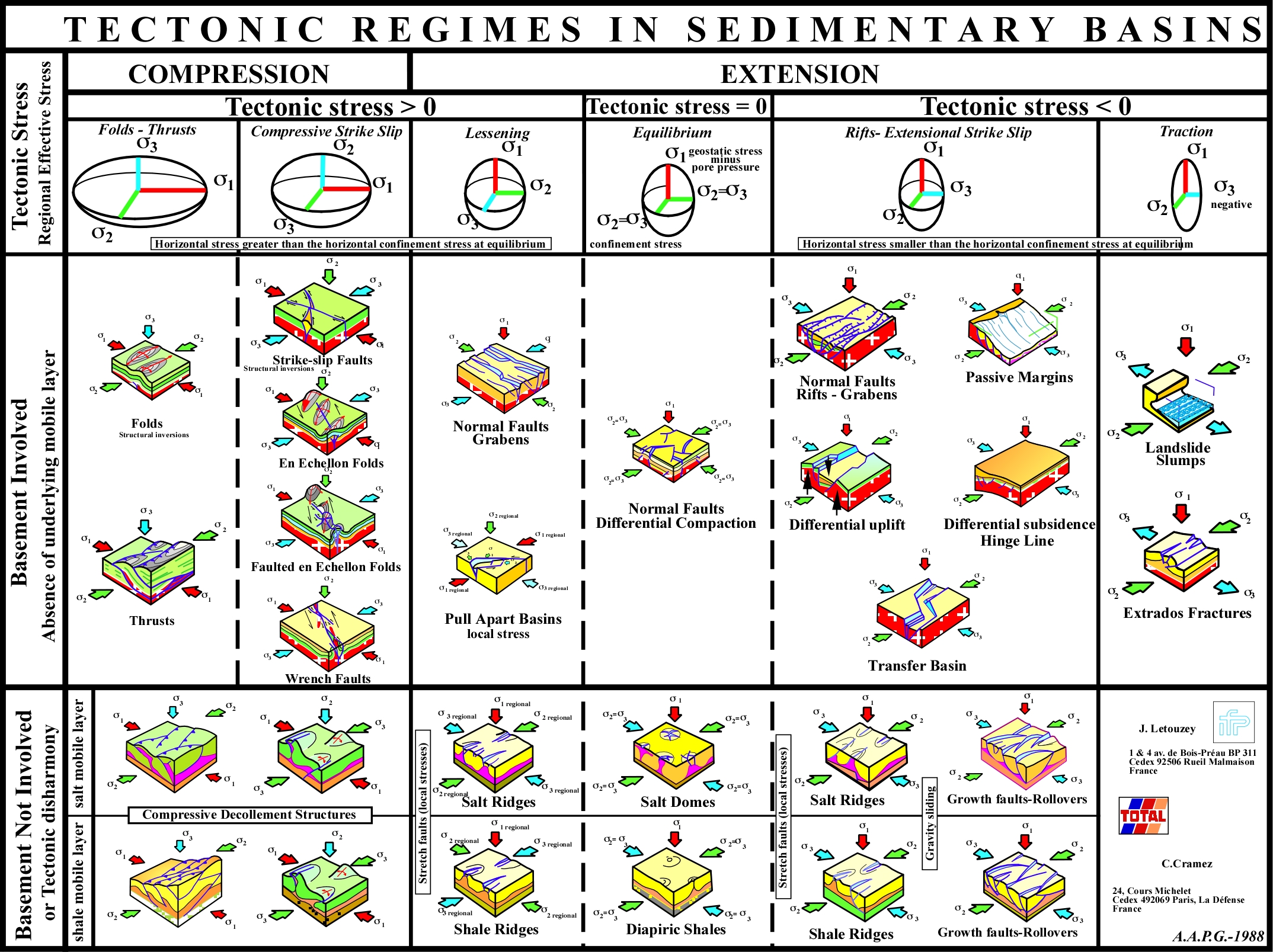
1.3- Stress Evolution in Tectonics
Depending on the geostatic (![]() g) and tectonic stress (
g) and tectonic stress (![]() t), the effective stresses ellipsoid changes in time and space (fig. 7). When the tectonic stress is positive (right side of fig. 7), the effective stresses ellipsoid can be vertically oblong or horizontally stress (
t), the effective stresses ellipsoid changes in time and space (fig. 7). When the tectonic stress is positive (right side of fig. 7), the effective stresses ellipsoid can be vertically oblong or horizontally stress (![]() t), conventionally, when
t), conventionally, when ![]() 1 is vertical, the sediments are lengthened (extension). Contrariwise, when
1 is vertical, the sediments are lengthened (extension). Contrariwise, when ![]() 1 is horizontal, the sediments are shortened (compression). In the second case,
1 is horizontal, the sediments are shortened (compression). In the second case,![]() 1 is horizontal and the sediments will be shortened whether by folding or reverse faulting. In this hypothesis, when
1 is horizontal and the sediments will be shortened whether by folding or reverse faulting. In this hypothesis, when ![]() 2 is vertical, the sediments will be shortened by conical-folds (en échellon-folds) and compressional strike slip-faults.
2 is vertical, the sediments will be shortened by conical-folds (en échellon-folds) and compressional strike slip-faults.
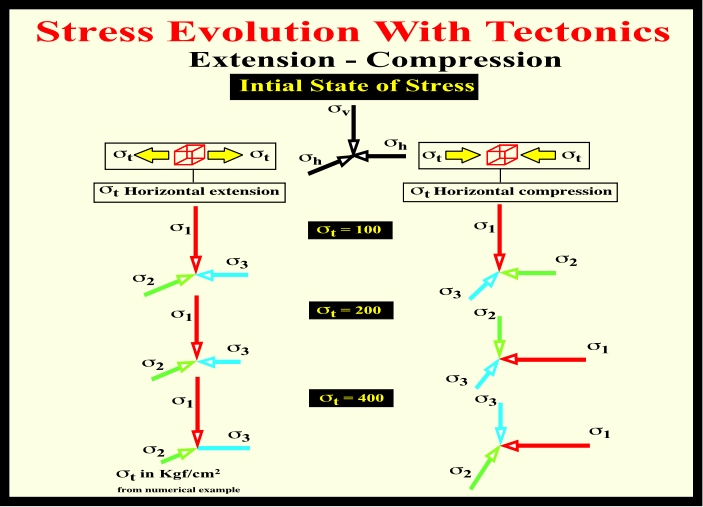
Fig. 7- At a given depth-point,
t > 0 and
t < 0 (100, 200 and 400 kgf/cm2) were added to
h of the initial state of stress (
v,
h). At a given depth point, the state of stress corresponds to the addition of
g and
p. One can say the state of stress corresponds to the
g decreased of the
p. Hydrostatic pressure acts in opposite sense of lithostatic pressure.The left column pictures the extensional tectonic regimes, in which
1 is vertical and by which the sediments will be lengthened. The right column pictures the tectonic regimes induced by a
t > 0. When st is too small (100 kgf/cm2), sediments will be lengthened (extension). When
t is big enough to balance the geostatic pressure, sediments will be shortened whether by cylindrical-folds and reverse-faults (
3 vertical) or by conical-folds and compressional strike slip-faults (
2 vertical).
As said previously, when ![]() 1 is vertical, sediments are lengthened by normal-faults striking parallel to the
1 is vertical, sediments are lengthened by normal-faults striking parallel to the ![]() 2. The amplitude of the tectonics stress (
2. The amplitude of the tectonics stress (![]() t) does not change the orientation of the principal axes of the effective stresses ellipsoid (
t) does not change the orientation of the principal axes of the effective stresses ellipsoid (![]() 1,
1, ![]() 2,
2, ![]() 3). Just the throw of the normal-faults becomes progressively higher as the tectonic stress increases.
3). Just the throw of the normal-faults becomes progressively higher as the tectonic stress increases.
1.4- Salt Tectonics in Sedimentary Basins
Table II
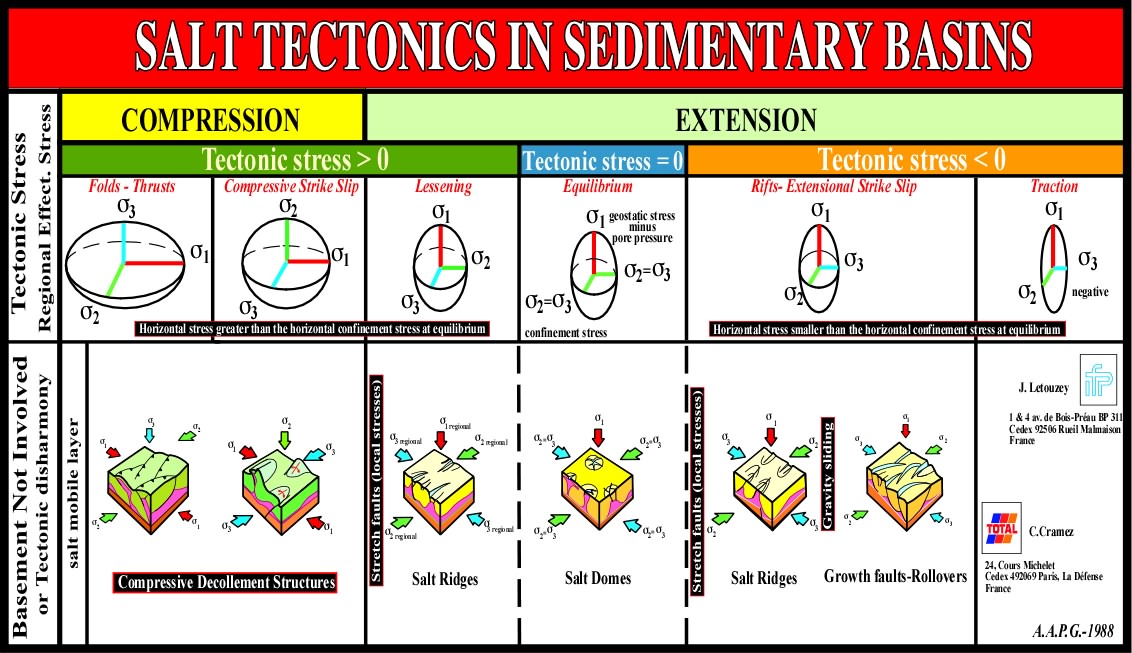
1.4.1- Folds & Thrusts, st > 0 (see Table II)
Under a tectonic regime characterized by an effective stresses ellipsoid with ![]() 1 horizontal and
1 horizontal and ![]() 3 vertical (fig. 8), without basement involved (see Table I), the sediments (with and an interbedded salt layer), will be lengthened by cylindrical-folds and reverse or thrust-faults. As the basement is not involved and as a mobile layer (salt layer) is present, a tectonic disharmony will be developed at the bottom of the salt. The cover (salt plus overburden) will be deformed independently of the infra-salt strata, suggesting the cover transmitted the effective stresses. Depending of the rheology and geometric configuration of the sediments, a stress field can affect an area without apparent deformation. In a compressional tectonic regime, deformations are often confined to deformation tracks or "couloirs". Rigid blocks transmit stresses without apparent deformations
3 vertical (fig. 8), without basement involved (see Table I), the sediments (with and an interbedded salt layer), will be lengthened by cylindrical-folds and reverse or thrust-faults. As the basement is not involved and as a mobile layer (salt layer) is present, a tectonic disharmony will be developed at the bottom of the salt. The cover (salt plus overburden) will be deformed independently of the infra-salt strata, suggesting the cover transmitted the effective stresses. Depending of the rheology and geometric configuration of the sediments, a stress field can affect an area without apparent deformation. In a compressional tectonic regime, deformations are often confined to deformation tracks or "couloirs". Rigid blocks transmit stresses without apparent deformations
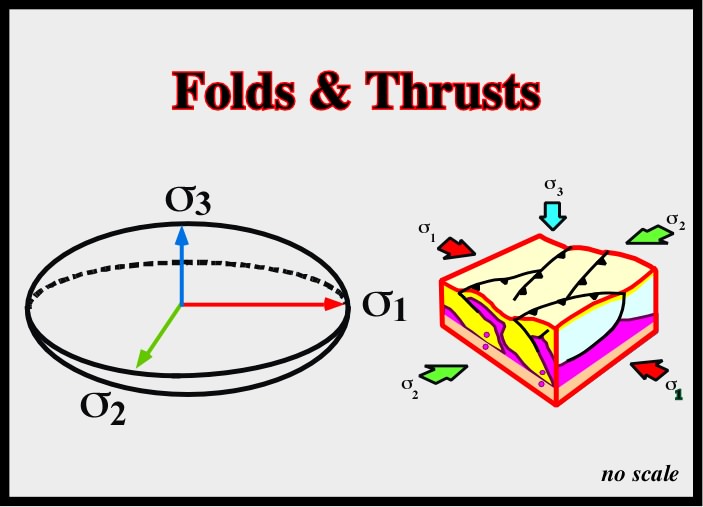
Fig. 8- A compressional tectonic regime, with a
3 vertical, shortens the sediments by cylindrical folding and reverse faulting. The sediments are shortened and uplifted, since
3 is vertical. The axes of the folds are perpendicular to
1 and the associated faults (reverse and thrust) strike more or less parallel to
2, following the Mohr’s circle failure principle. The interbedded salt layer is deformed in concordance with the overburden. However, later on, locally, the salt layer can be deformed by halokinesis, whenever the effective stresses ellipsoid becomes vertically oblong and biaxial (
1 vertical,
2 =
3).
As ![]() 3 is vertical, the sediments may be lifted above regional. This uplift creates a relative sea-level fall, which induces an erosional surface, that is to say, an unconformity, which may be fossilized by onlapping of recent sediments. The salt layer is deformed in concordance with the overburden. Halokinesis can predate or postdate the compressional deformation, depending on the geological history of the basin considered (halokinesis will be studied later). On the ground, as well as on geological and geophysical maps, cylindrical-folds strike roughly parallel the medium effective stress,
3 is vertical, the sediments may be lifted above regional. This uplift creates a relative sea-level fall, which induces an erosional surface, that is to say, an unconformity, which may be fossilized by onlapping of recent sediments. The salt layer is deformed in concordance with the overburden. Halokinesis can predate or postdate the compressional deformation, depending on the geological history of the basin considered (halokinesis will be studied later). On the ground, as well as on geological and geophysical maps, cylindrical-folds strike roughly parallel the medium effective stress, ![]() 2. Reverse-faults and thrust-faults strike also parallel to
2. Reverse-faults and thrust-faults strike also parallel to![]() 2. The cylindrical folds are parallel to the faults and located in the up-thrown faulted blocks. Similarly, the fault planes dip toward the up-thrown blocks, where uplift takes place, and so they must have a relay-geometry (fig. 8, block diagram).
2. The cylindrical folds are parallel to the faults and located in the up-thrown faulted blocks. Similarly, the fault planes dip toward the up-thrown blocks, where uplift takes place, and so they must have a relay-geometry (fig. 8, block diagram).
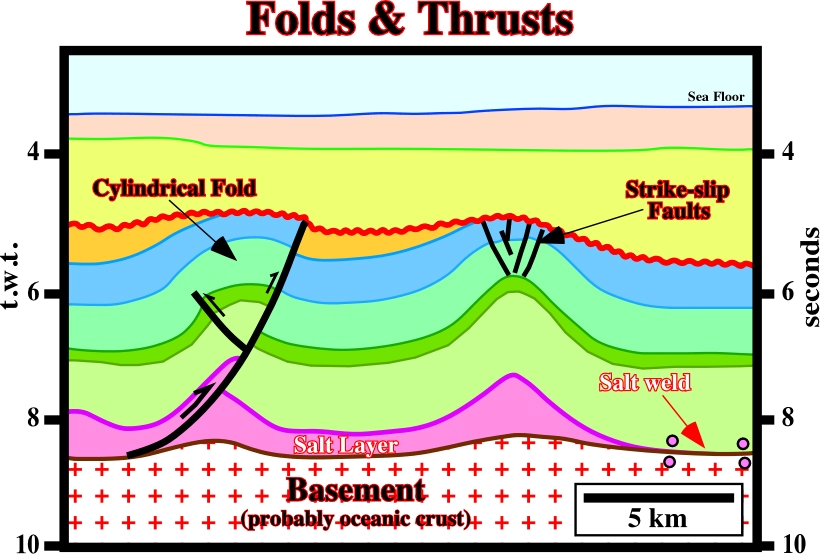
Fig. 9- In this example, halokinesis is restricted to right end of the line (salt weld, see later). The cover (salt plus overburden) is prekinematic or and postkinematic. There are not synkinematic layers as usually in the halokinesis. The faults in the apex of the salt anticline are compressional strike-slip faults and not normal faults. They are contemporaneous of deformation. The faults on the left structure (cylindrical fold) are reverse-faults.
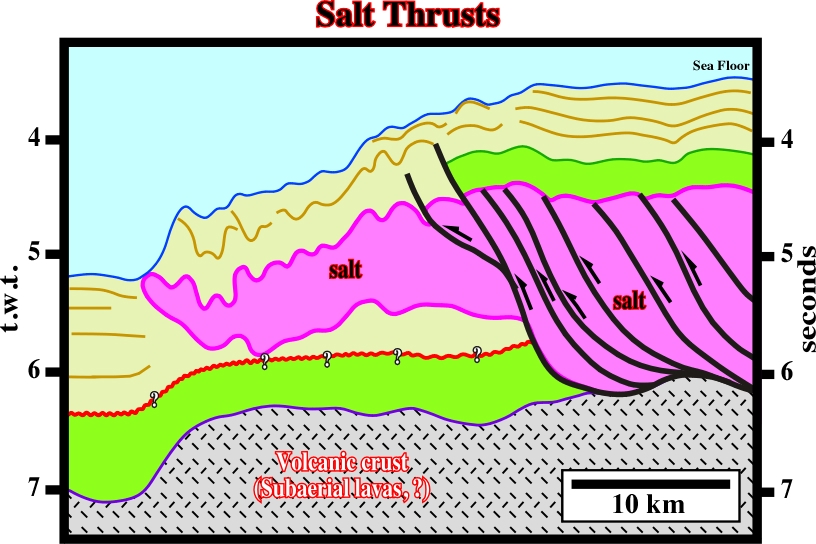
Fig. 10- Salt thrust-faults are quite frequent in the deep offshore, near the seaward limit of salt basins, where salt layers are often thickened by thrusting. They were created by local compressional tectonic regimes induced by coeval up-dip extensions. Often, they are associated with allochthonous salt as illustrated on this seismic line. Notice, that a simple depth conversion shows a huge landward step, on the top of the volcanic crust, which can be interpreted as the seaward limit of the salt basin or salt deposition.
This tectonic regime is frequent in sedimentary basins associated with the formation of megasutures, particularly in episutural and perisutural. In such geological contexts, the basement is generally involved in the deformation and evaporitic deposits are not too frequent. However, the Neunquen basin (fig. 12), in South America, and the Salt Ranges, in Pakistan, are meaningful exceptions.
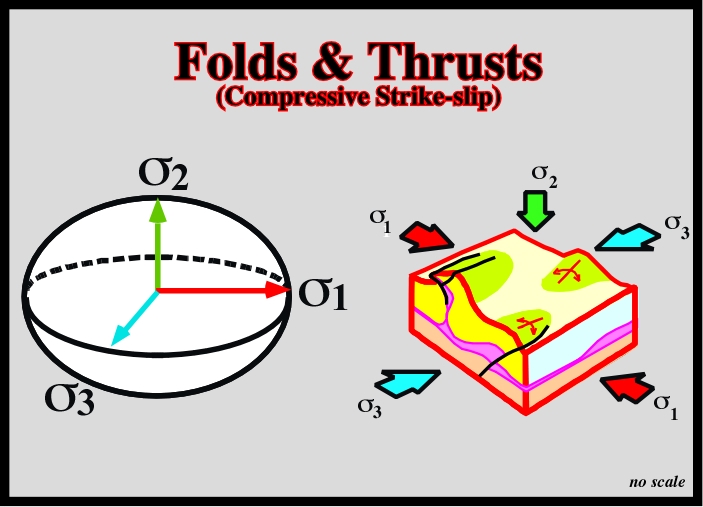
When thick evaporite intervals are frequent, as in the case in South Atlantic margins, either offshore Angola or in offshore Brazil, this compressional tectonic regime, which is characterized by ![]() 2 vertical, is often found in association with fracture zones. In fact, it is well known that (i) changes in the rate of sea floor spreading, (ii) lithospheric plates readjustment or (iii) ridge-push forces, can reactivate the fracture zones creating compressional structures in the cover. Generally, the more common structures are conical anticlines with the salt in the core of the structure (in contrast to a cylindrical anticline, a conical anticline when pictured in a stereographic projection lies in a Parallel and not in a Meridian). However, when the amplitude of the lateral displacement is quite significant (> 5 km), folding cannot accommodate the shortening of the cover, thereby faulting takes also place. In North Sea, this tectonic regime is found in association with the reactivation of old normal faults (tectonic inversion), particularly when the
2 vertical, is often found in association with fracture zones. In fact, it is well known that (i) changes in the rate of sea floor spreading, (ii) lithospheric plates readjustment or (iii) ridge-push forces, can reactivate the fracture zones creating compressional structures in the cover. Generally, the more common structures are conical anticlines with the salt in the core of the structure (in contrast to a cylindrical anticline, a conical anticline when pictured in a stereographic projection lies in a Parallel and not in a Meridian). However, when the amplitude of the lateral displacement is quite significant (> 5 km), folding cannot accommodate the shortening of the cover, thereby faulting takes also place. In North Sea, this tectonic regime is found in association with the reactivation of old normal faults (tectonic inversion), particularly when the ![]() 1 of the compressional regime is not orthogonal to the strike of the original normal faults.
1 of the compressional regime is not orthogonal to the strike of the original normal faults.
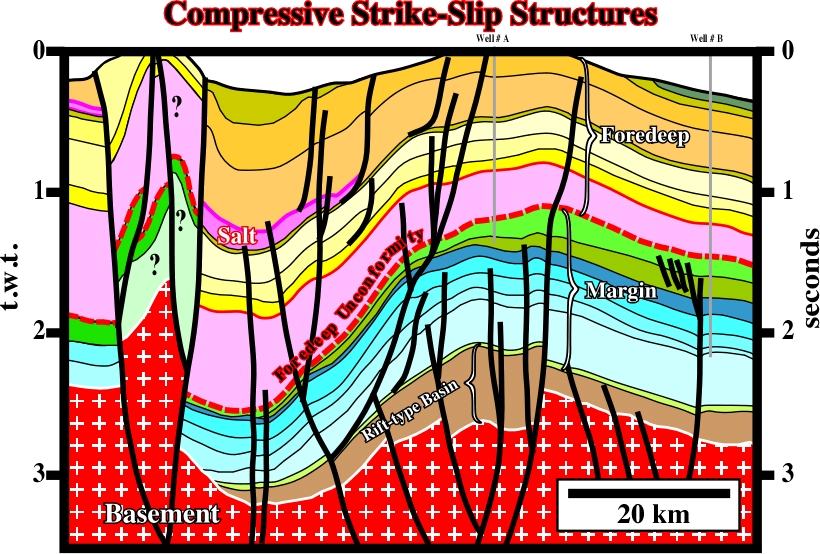
Fig. 12- This seismic line, from the Neuquen basin (onshore Argentine), illustrates a compressive strike-slip shortening of the foredeep sediments, in which a Cretaceous evaporitic layer (Hutrim formation) was deformed in concordance with all other intervals. Similarly, but no so evident, an Oxfordian salt layer (Auquilco formation) was inverted (inverted rift-type basin in lower middle part of the line) with development of “en echelon folds” in the up-thrown faulted block. Notice, that two different compressional tectonic regimes, one with the basement involved and a younger without involvement of the basement can also explained the deformation recognized on this line.

This tectonic regime is characterized by an effective stresses ellipsoid with ![]() 1 vertical. Generally, it is found on the distal part of foredeep basins, far away from the folded belt. As pictured on Table I and II, this tectonic regime is developed when
1 vertical. Generally, it is found on the distal part of foredeep basins, far away from the folded belt. As pictured on Table I and II, this tectonic regime is developed when ![]() t > 0, but not big enough to invert the biaxial vertically oblong state of stress ellipsoid. As illustrated in fig. 15, the tectonic stress decreases with the distance to the frontal-thrusts of the folded-belt.
t > 0, but not big enough to invert the biaxial vertically oblong state of stress ellipsoid. As illustrated in fig. 15, the tectonic stress decreases with the distance to the frontal-thrusts of the folded-belt.
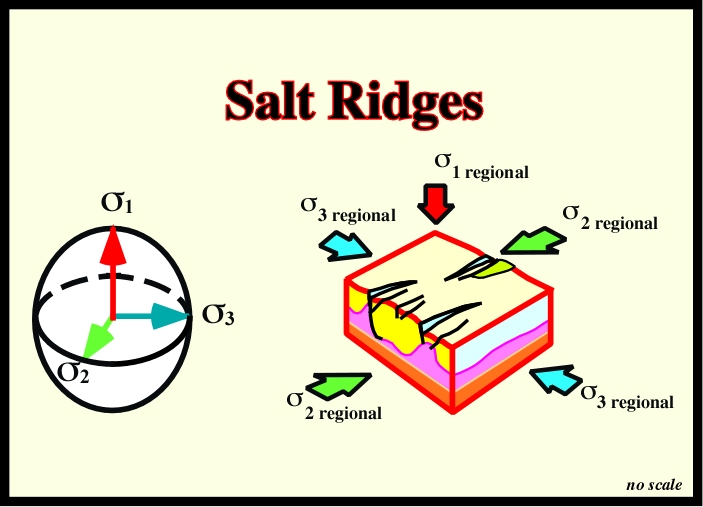
Fig. 14- When an evaporitic interval is present in a stratigraphic column undergone a tectonic regime with
1 vertical created by a
t > 0, it is deformed into more or less parallel salt ridges. Indeed, salt ridges are extensional structures (antiforms), which often form the core of regional extensional depressions (grabens) striking perpendicular to the axes of the folds and reverse-faults of the folded belt. Therefore, salt deformation and normal faulting are coeval.
The last conjecture is mainly a pedagogic statement. In fact, it is easier to consider a changing in the tectonic stress that a changing in the rheology of the sediments. The algorithms are simpler. Actually, in the ground, the tectonic stress does not change. What really change are the rheologic characteristics of the sediments, which are function of the temperature, pressure and tectonic heritage. Deformation occurs when, and where, sediments lost strength to deformation. Nevertheless, assuming the tectonic stress (![]() t) progressively decrease in direction of the craton (platform), the structures recognized on the ground: (i) Cylindrical-Folds and Thrusts, (ii) Conical-Folds and Compressive Strike Slip-Faults and (iii) Normal-faults, suggest three tectonic provinces with different tectonic regimes characterized by:
t) progressively decrease in direction of the craton (platform), the structures recognized on the ground: (i) Cylindrical-Folds and Thrusts, (ii) Conical-Folds and Compressive Strike Slip-Faults and (iii) Normal-faults, suggest three tectonic provinces with different tectonic regimes characterized by:
(a)
1 horizontal and
3 vertical.
(b)1 horizontal and
2 vertical.
(c)1 vertical and
2 horizontal but parallel to
1 of the other regimes.
The structures created by (a) can coexist with structures created by (b), but not with those created by (c). The structures created by (c) can coexist with those created by (b). The structures created by (b) can coexist with those created by (a) and (c).
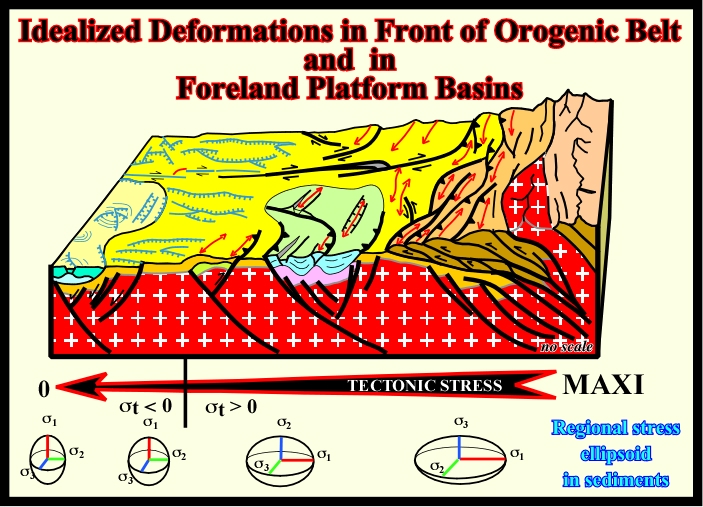
Fig. 15- This sketch illustrates the conjecture that the tectonic stress decrease progressively in direction of the craton, that is to say, away from the orogenic belt. Indeed, the tectonic stress is more or less constant within the considered lithospheric plate. However, as the strength to deformation of the rocks change, deformation occurs where the sediments cannot stand anymore the effective stresses. In such a tectonic setting, when
1 is vertical, salt layers, if they were deposited will be deformed in salt ridges striking perpendicularly to the cylindrical-folds and thrusts of the fold-belt.
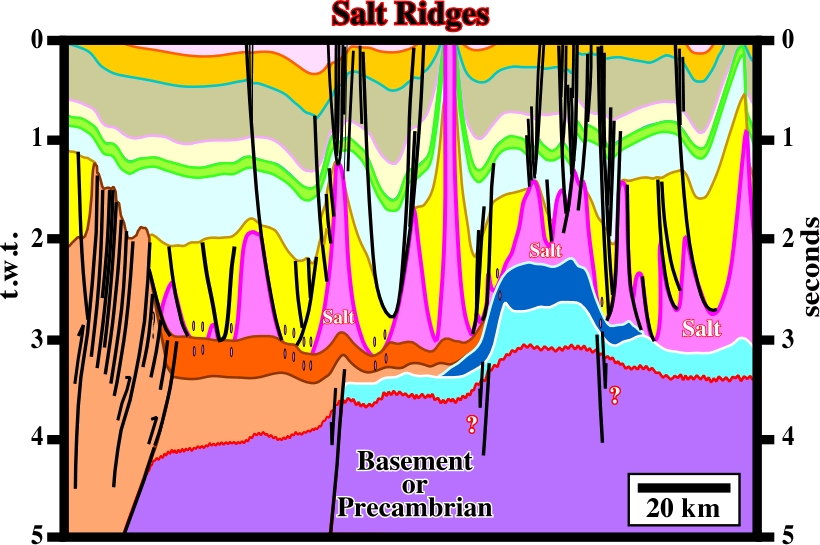
This tectonic regime occurs when the tectonic stress is nil (![]() t = 0). It is an extensional tectonic regime characterized by a vertically oblong biaxial effective stresses ellipsoid;
t = 0). It is an extensional tectonic regime characterized by a vertically oblong biaxial effective stresses ellipsoid; ![]() 1 is vertical and
1 is vertical and ![]() 2 and
2 and ![]() 3 are horizontal and equals. In such a tectonic setting, when a salt layer is present, due to the salt properties (see later), it can be deformed by lateral or vertical flowage, creating a compensatory subsidence, which will control the accommodation of the synkinematic sediments.
3 are horizontal and equals. In such a tectonic setting, when a salt layer is present, due to the salt properties (see later), it can be deformed by lateral or vertical flowage, creating a compensatory subsidence, which will control the accommodation of the synkinematic sediments.
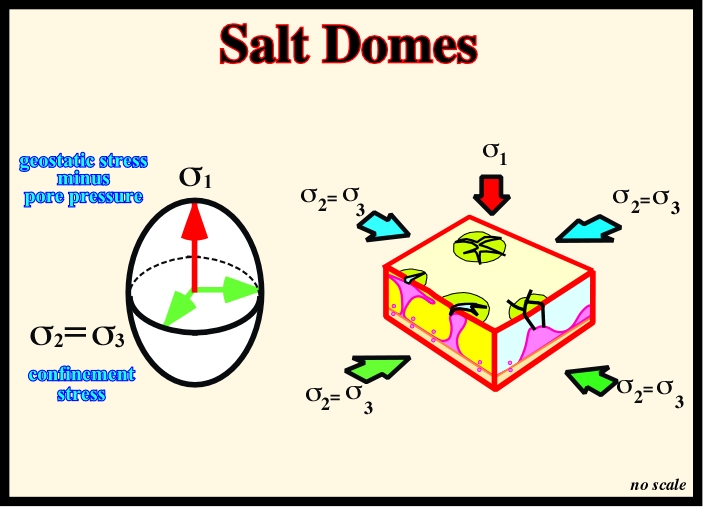
Fig. 17- As illustrated in the block diagram, the faulting associated with this tectonic regime is characterized by normal-faults striking in all directions (
2 =
3). This fault pattern is also often recognized on antiform structures created by differential compaction. When, a thick mobile layer (salt or under-compacted shale) is present, even in absence of a significant tectonic stress, it can flow by itself. Halokinesis designates the salt and overburden deformations taking place in such a tectonic setting (absence of a tectonic stress), while argilokinesis denotes the deformations associated with an under-compacted shale interval.
Under such tectonic conditions, the normal-faults lengthening the sediments (overburden, when a salt layer is present) strike in all azimuths (“radial faults”). Theoretically, radial normal-faults are created in order to solve a volume problem. When a salt layer flows upward, due to the contrast of density between the salt and the surrounding sediments, it creates a more or less circular salt diapir and thereby the overburden is lengthened around it. As the lengthening creates a potential void, and as nature dislikes vacuity, radial normal-faults extend the overburden in order to fill the space created. So, theoretically, in a cross-section, the addition of opposite normal fault throws should be roughly zero. Admittedly, halokinesis is not limited to a homogeneous upward flowage of salt. Indeed, as we see later, from physics standpoint, salt diapirs, with vertical walls, are stable structures; the salt of the upper part of salt diapirs is forced to flow laterally. Actually, contrary to sediments, the density of salt does not change with depth (salt cannot be compacted). The density of the surrounding sediments increases with depth due to compaction.
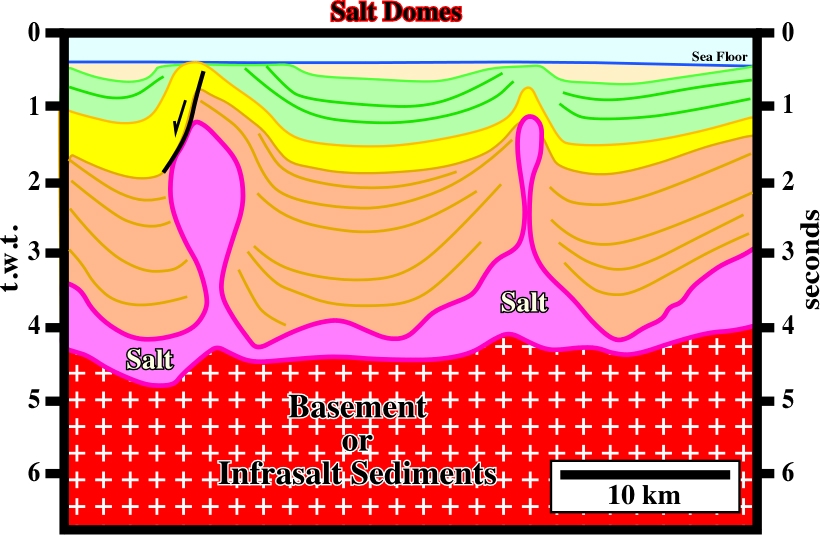

Fig. 19- This antiform structure is a typical extensional structure created by halokinesis. The lateral depocenters is a synkinematic intervals deposited in association with a compensatory subsidence created by salt flowage. The core of the structure, which is mainly prekinematic, was inverted by halokinesis. The normal-faults (with opposite vergence) near the apex of the structure strongly extend the overburden.
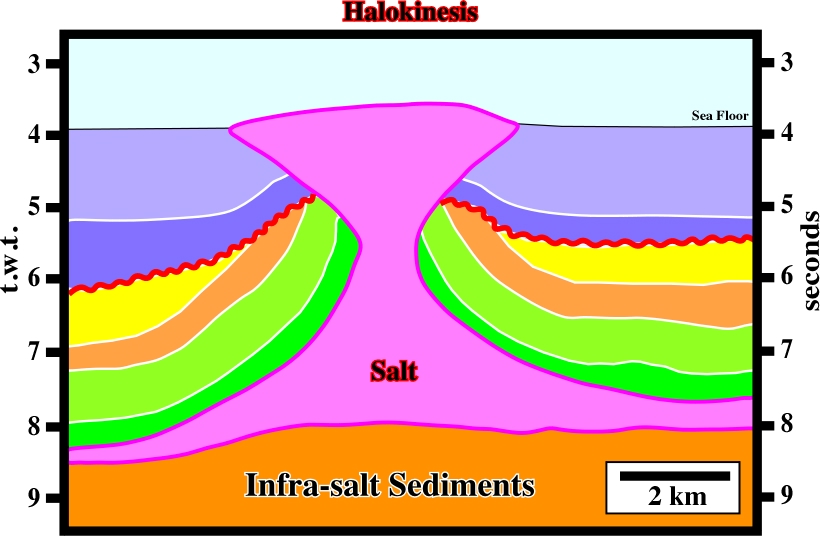
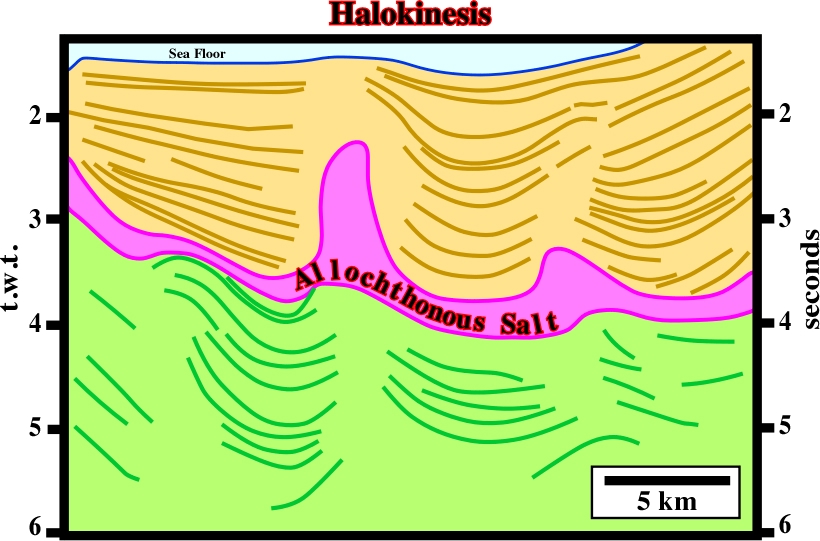
Fig. 21- Halokinesis can create complex structures particularly when there is superimposition of autochthonous and allochthonous salt structures, as is the case on this seismic line from Garden Banks (deep-water Gulf of Mexico), where, at least two salt-induced tectonic disharmonies or décollement surfaces can predicted.
1.4.5- Rifts – Extensional Strike-Slip,
t < 0 (see Table II)
Under this tectonic regime, which is characterized by a vertically oblong triaxial effective stresses ellipsoid with ![]() 1 vertical, and
1 vertical, and ![]() 2 and
2 and ![]() 3 horizontal, the cover is lengthened, whether the basement is involved or not in the deformation. When a salt layer is present, it can be deformed in salt ridges (fig. 22) or in growth-faults (fig. 23).
3 horizontal, the cover is lengthened, whether the basement is involved or not in the deformation. When a salt layer is present, it can be deformed in salt ridges (fig. 22) or in growth-faults (fig. 23).
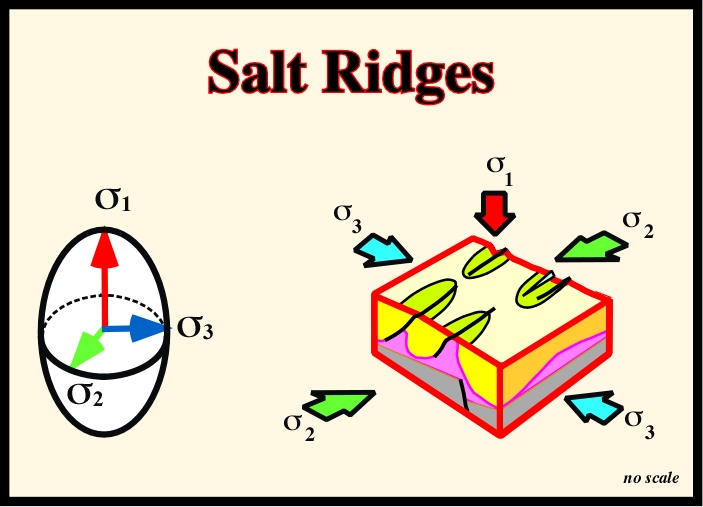
Fig. 22- Salt ridges are parallel to
2, which generally is more or less parallel to the shoreline of the divergent margins where this tectonic regime is common (fig. 24).

Fig. 23- Growth faults are often created by lateral salt flowage. Residual salt can is frequently recognised in the up-thrown faulted block under the form of salt rollers.
Very often, growth-faults are associated with salt ridges. Therefore, generally, it is difficult to differentiate a salt ridge with a growth-fault, from a simple growth-fault developed on a mobile salt substratum. The best criterion, as pictured on the previous block diagrams, seems to be the cartographic geometry:
(i) Salt ridges have a more or less unbent geometry. The normal-faults associated with them are more or less rectilinear.
(ii) Growth-faults have a curvilinear geometry. Therefore, individually, they create a non-homogeneous extension. So, the association of an indefinite number of growth-faults is required (Curvilinear-faults are often called listric faults because in a cross-section, they have a decreasing hade. The term listric comes from the Greek « listron », which means shovel, what is not synonym of decreasing hade. Up-dip, a listric fault has a normal geometry, while down-dip, its geometry becomes reverse).
At the ground surface and on time contour maps, very often, the cartography of the growth faults is in relay. The maximum extension (maximum throw) of one fault is relayed with the minimum of extension (minimum throw) of the next fault (see fig. 23). Such geometry allows homogeneous lengthening (without wrenching). On this subject, it is important to remember that all curvilinear faults (normal or reverse) have a maximum extension (maximum throw) between the ends, where the extension is zero.
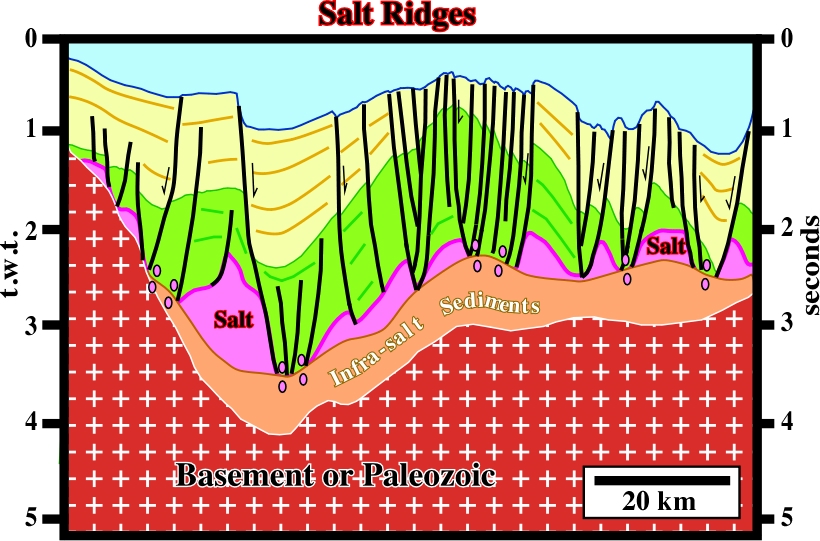
Fig. 24- The lengthening of the sediments is evident. The tectonic regime is characterized by
1 vertical. The antiform morphology of the sea bottom is quite significant. The majority of the normal-faults die on the tectonic disharmony associated with the salt layer (top of the salt). The sediments above and below the tectonic disharmony show different deformations. Above it, the substratum, that is to say, the salt, and overburden have been strongly extended (the extension still is going on). Below the tectonic disharmony, the infra-salt strata are just slightly deformed. The cartography of the salt structures, which are bordered by normal-faults, indicates they have a more or less rectilinear geometry. Thereby, they can be classified as salt ridges striking parallel to
2.
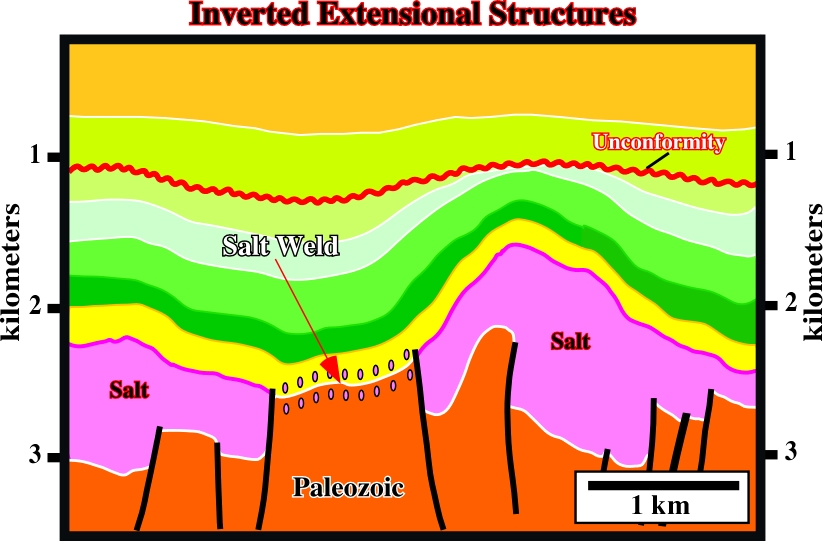
Fig. 25- The salt weld in the central part of the line suggests that before deformation the salt layer was continuous between the yellow and brown interval. Then, the infra-salt strata were lengthened by normal-faults creating potential voids that were filled by salt (“salt grabens”) due to a lateral salt flowage, which created a window in the salt layer. Finally, a compressional tectonic regime shortened the cover inverting the salt grabens.

Fig. 26- Salt ridges and growth faults are frequent in Santos basin (offshore Brazil). Taking into account that the deformation of the infra-salt strata is apparent and due to velocity-induced lateral pull-ups, one can say that below the tectonic disharmony the sediments are almost undeformed. Above it, salt ridges and growth faults extended the overburden.

Fig. 27- In deep water Angola, Cretaceous sediments and particularly the Pinda formation, which is a potential reservoir interval in the offshore shelf, were extended by growth-faults developed on the top of the salt layer due to an extensional tectonic regime characterized by
1 vertical,
2 horizontal striking more or les N-S and
3 horizontal and W-E.
1.5- Summary of Salt Extensional Tectonic Deformation (see Table III)
Before reviewing the basic principles of halokinesis, on table III, we will sum up the main extensional deformations associated with a mobile salt layer. The tri-dimensional geometry of the structures:
(i) Salt Ridges (
t > 0)
(ii) Halokinetic Structures (
t = 0)
(iii) Salt Ridges, Growth Faults, Gravity Sliding (
t < 0)
and the associated time contour maps are proposed. Special attention should be paid to the proposed block diagrams in order to better understand the second part of this short course, in which 3D seismic data is used. Indeed, it is important to realize that a time slice is just a geological map with a flat topography. However, time-slices, as well as geological maps without topography, are not necessary similar to time contour maps. This is particularly true for the geometry of the fault planes. In fact, as shown by G. Dickinson (1954), the effects of intersecting faults in subsurface and time contours maps are very difficult to comprehend especially on flat geological maps due to topography effect. Ex: In a time contour map, when two normal fault affecting horizontal strata intersect, it is the younger fault that is displaced and not the older one.
Table III
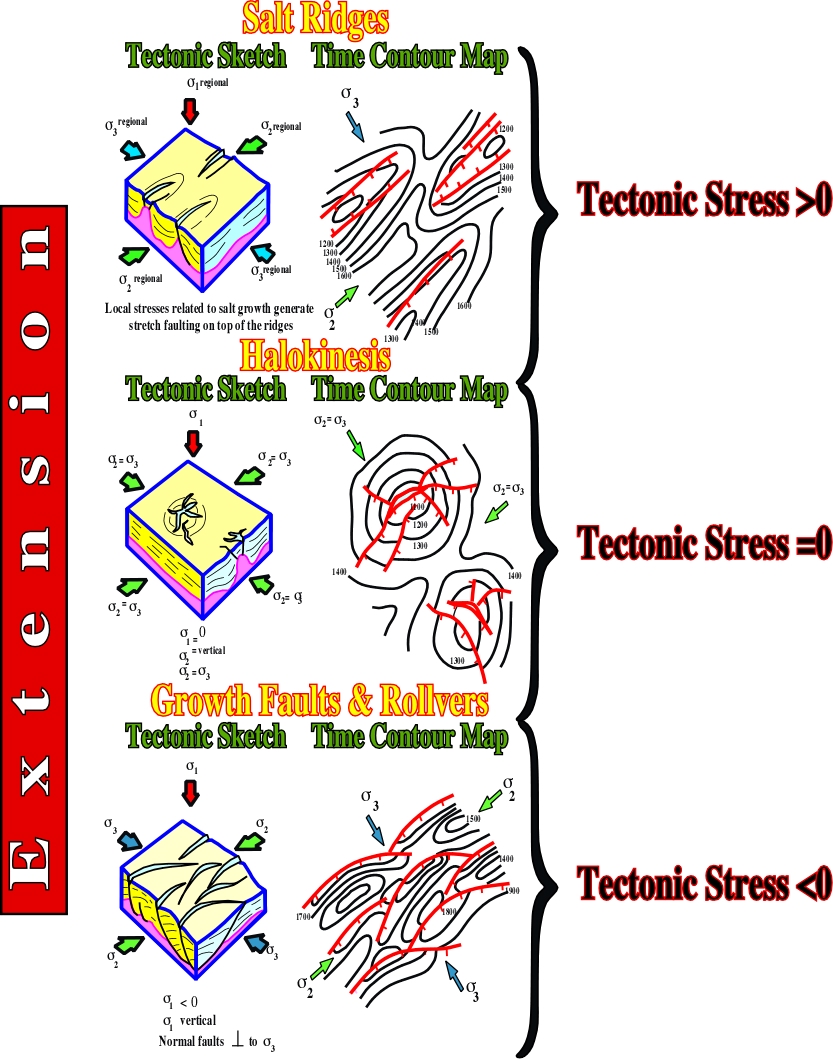
to continue press
next